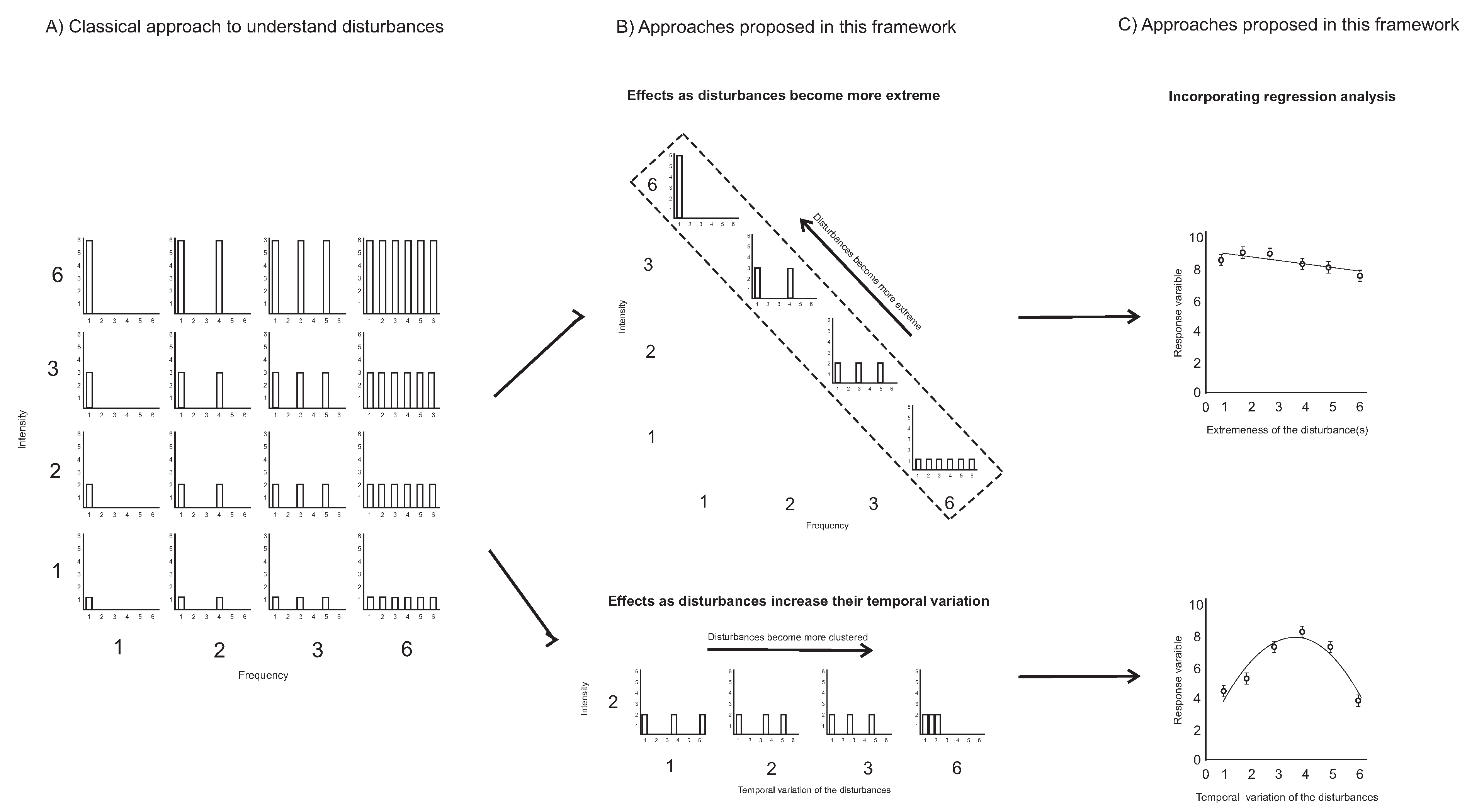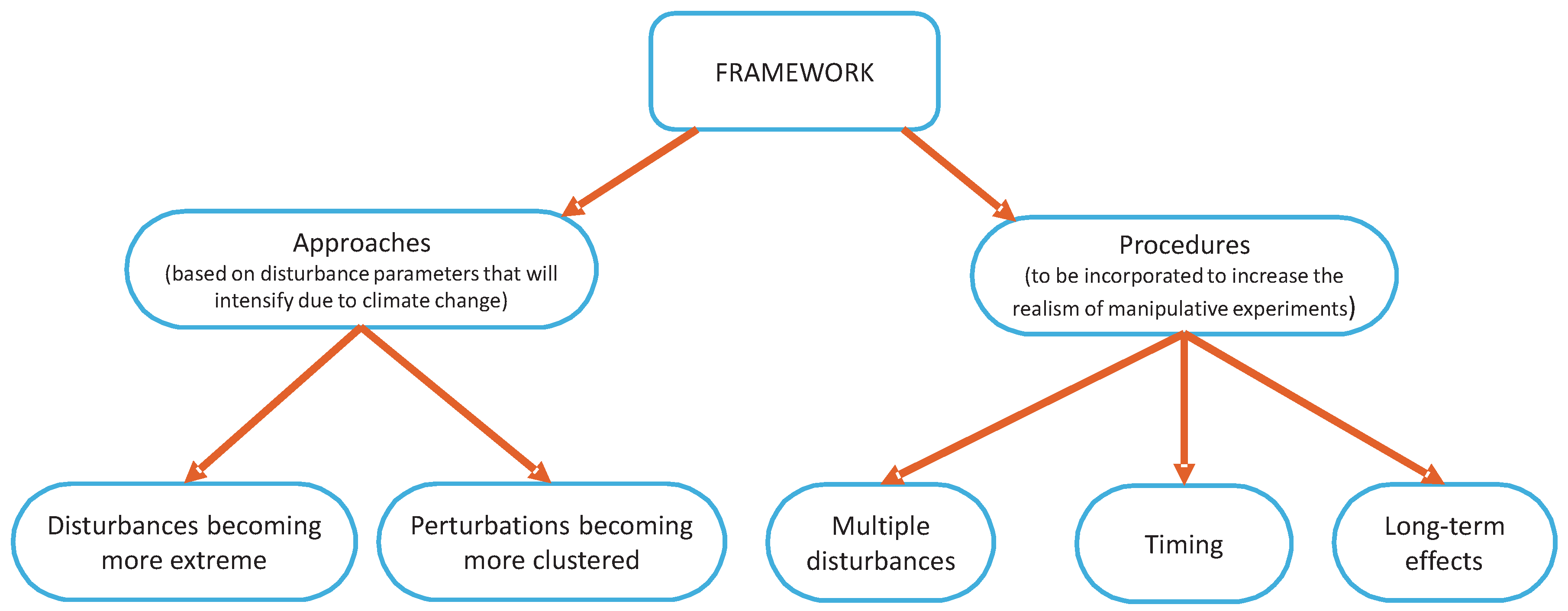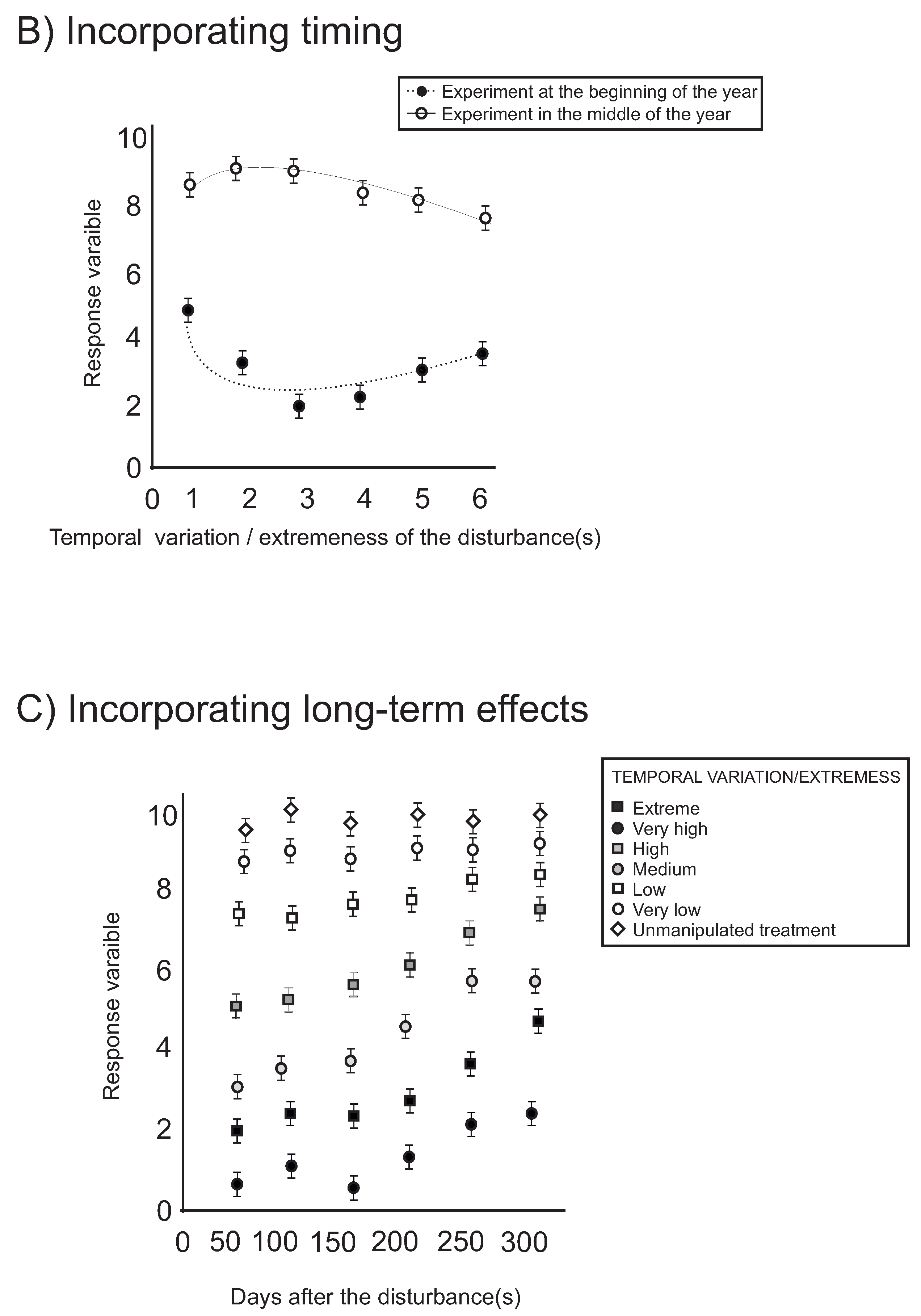A Framework to Advance the Understanding of the Ecological Effects of Extreme Climate Events
Abstract
1. Introduction
2. Disturbances
3. Studying Extreme Events
4. A Framework to Advance in Extreme Event Experiments
4.1. Experimental Approaches
4.2. Procedures
4.2.1. Multiple Disturbances
4.2.2. Timing
4.2.3. Long-Term Effects
4.2.4. Combining Several Procedures
5. A Pledge to do More Integrative Approaches Considering both Marine and Terrestrial Realms
6. Rocky Shores as A Case Study
6.1. Experimental Approaches Adapted to Rocky Shores
6.2. Procedures Adapted to Rocky Shores
6.2.1. Multiple Disturbances
6.2.2. Timing
6.2.3. Long-term Effects
6.2.4. Incorporating Complexity and Adapting this Framework to Specific Extreme Events and Ecosystems
7. Discussion
8. Conclusions
Acknowledgments
Conflicts of Interest
References
- United Nations. The Sustainable Development Goals Report; United Nations Publication: New York, NY, USA, 2017. [Google Scholar] [CrossRef]
- IPCC. Climate Change 2014: Synthesis Report; IPCC: Geneva, Switzerland, 2014. [Google Scholar] [CrossRef]
- Johnstone, J.F.; Allen, C.D.; Franklin, J.F.; Frelich, L.E.; Harvey, B.J.; Higuera, P.E.; Mack, M.C.; Meentemeyer, R.K.; Metz, M.R.; Perry, G.L.; et al. Changing disturbance regimes, ecological memory, and forest resilience. Front. Ecol. Environ. 2016, 14, 369–378. [Google Scholar] [CrossRef]
- Jentsch, A.; Kreyling, J.; Beierkuhnlein, C. A new generation of climate change experiments: Events, not trends. Front. Ecol. Environ. 2007, 5, 365–374. [Google Scholar] [CrossRef]
- Easterling, D.R.; Meehl, G.A.; Parmesan, C.; Changnon, S.A.; Karl, T.R.; Mearns, L.O. Climate extremes: Observations, modeling, and impacts. Science 2000, 289, 2068–2074. [Google Scholar] [CrossRef] [PubMed]
- Trapp, R.J.; Diffenbaugh, N.S.; Brooks, H.E.; Baldwin, M.E.; Robinson, E.D.; Pal, J.S. Changes in severe thunderstorm environment frequency during the 21st century caused by anthropogenically enhanced global radiative forcing. Proc. Natl. Acad. Sci. USA 2007, 104, 19719–19723. [Google Scholar] [CrossRef]
- Stephenson, D. Definition, diagnosis and origin of extreme weather and climate events. Clim. Extrem. Soc. 2011, 11–24. [Google Scholar] [CrossRef]
- Wernberg, T.; Smale, D.A.; Tuya, F.; Thomsen, M.S.; Langlois, T.J.; De Bettignies, T.; Bennett, S.; Rousseaux, C.S. An extreme climatic event alters marine ecosystem structure in a global biodiversity hotspot. Nat. Clim. Chang. 2013. [Google Scholar] [CrossRef]
- Ummenhofer, C.C.; Meehl, G.A. Extreme weather and climate events with ecological relevance: A review. Philos. Trans. R. Soc. B Biol. Sci. 2017, 372. [Google Scholar] [CrossRef]
- Smith, M.D. An ecological perspective on extreme climatic events: A synthetic definition and framework to guide future research. J. Ecol. 2011, 99, 656–663. [Google Scholar] [CrossRef]
- Editorial. Cause and effect. Nat. Methods 2010, 7, 243. [Google Scholar] [CrossRef][Green Version]
- Altwegg, R.; Visser, V.; Bailey, L.D.; Erni, B. Learning from single extreme events. Philos. Trans. R. Soc. B Biol. Sci. 2017. [Google Scholar] [CrossRef]
- Schutt, R.K.; Chambliss, D.F. Causation and Experimental Design. Making Sense of the Social World: Methods of Investigation, 3rd ed.; Sage Publications: Thousnad Oaks, CA, USA, 2011; pp. 106–135. [Google Scholar] [CrossRef]
- Van de Pol, M.; Jenouvrier, S.; Visser, M.E. Behavioural, ecological and evolutionary responses to extreme climatic events: Challenges and directions. Philos. Trans. R. Soc. B Biol. Sci. 2017, 372, 20160372. [Google Scholar] [CrossRef] [PubMed]
- Kreyling, J.; Beier, C. Complexity in Climate Change Manipulation Experiments. Bioscience 2014. [Google Scholar] [CrossRef]
- Garrabou, J.; Ballesteros, E.; Zabala, M. Structure and dynamics of north-western Mediterranean rocky benthic communities along a depth gradient. Estuar. Coast. Shelf. Sci. 2002. [Google Scholar] [CrossRef]
- Camuffo, D.; Secco, C.; Brimblecombe, P.; Martin-Vide, J. Sea storms in the Adriatic Sea and the Western Mediterranean during the last millennium. Clim. Chang. 2000, 46, 209–223. [Google Scholar] [CrossRef]
- Kayler, Z.E.; De Boeck, H.J.; Fatichi, S.; Grünzweig, J.M.; Merbold, L.; Beier, C.; McDowell, N.; Dukes, J.S. Experiments to confront the environmental extremes of climate change. Front. Ecol. Environ. 2015, 13, 219–225. [Google Scholar] [CrossRef]
- Halpern, B.S.; Walbridge, S.; Selkoe, K.A.; Kappel, C.V.; Micheli, F.; D’agrosa, C.; Bruno, J.F.; Casey, K.S.; Ebert, C.; Fox, H.E.; et al. A global map of human impact on marine ecosystems. Science 2008. [Google Scholar] [CrossRef]
- Buma, B. Disturbance interactions: Characterization, prediction, and the potential for cascading effects. Ecosphere 2015, 6, 1–15. [Google Scholar] [CrossRef]
- Sippel, S.; Zscheischler, J.; Reichstein, M. Ecosystem impacts of climate extremes crucially depend on the timing. Proc. Natl. Acad. Sci. USA 2016, 113, 5768–5770. [Google Scholar] [CrossRef]
- De Boeck, H.J.; Dreesen, F.E.; Janssens, I.A.; Nijs, I. Whole-system responses of experimental plant communities to climate extremes imposed in different seasons. New Phytol. 2011. [Google Scholar] [CrossRef]
- Meisner, A.; De Deyn, G.B.; de Boer, W.; van der Putten, W.H. Soil biotic legacy effects of extreme weather events influence plant invasiveness. Proc. Natl. Acad. Sci. USA 2013, 110, 9835–9838. [Google Scholar] [CrossRef]
- De Boeck, H.J.; Hiltbrunner, E.; Verlinden, M.; Bassin, S.; Zeiter, M. Legacy effects of climate extremes in alpine grassland. Front. Plant Sci. 2018. [Google Scholar] [CrossRef] [PubMed]
- Rykiel, E.J. Towards a definition of ecological disturbance. Aust. J. Ecol. 1985. [Google Scholar] [CrossRef]
- Smith, M.D.; Knapp, A.K.; Collins, S.L. A framework for assessing ecosystem dynamics in response to chronic resource alterations induced by global change. Ecology 2009. [Google Scholar] [CrossRef] [PubMed]
- Lake, P.S. Disturbance, patchiness, and diversity in streams. J. N. Am Benthol. Soc. 2000, 19, 573–592. [Google Scholar] [CrossRef]
- Barnes, B.V.; Zak, D.R.; Denton, S.; Spurr, S. Forest Ecology; Wiley: New York, NY, USA, 1998. [Google Scholar]
- Connell, J.H.; Slayter, R.O. Mechanisms of succession in natural communities and their role in community stability and organization. Am. Nat. 1977, 111, 1119–1144. [Google Scholar] [CrossRef]
- Abrahamson, W.G. Species responses to fire on the Florida Lake Wales Ridge. Am. J. Bot. 1984. [Google Scholar] [CrossRef]
- Bailey, L.D.; van de Pol, M. Tackling extremes: Challenges for ecological and evolutionary research on extreme climatic events. J. Anim. Ecol. 2016, 85, 85–96. [Google Scholar] [CrossRef]
- Hughes, T.P.; Anderson, K.D.; Connolly, S.R.; Heron, S.F.; Kerry, J.T.; Lough, J.M.; Baird, A.H.; Baum, J.K.; Berumen, M.L.; Bridge, T.C.; et al. Spatial and temporal patterns of mass bleaching of corals in the Anthropocene. Science 2018. [Google Scholar] [CrossRef]
- Mumby, P.J.; Vitolo, R.; Stephenson, D.B. Temporal clustering of tropical cyclones and its ecosystem impacts. Proc. Natl. Acad. Sci. USA 2011. [Google Scholar] [CrossRef]
- Jiménez, M.A.; Jaksic, F.M.; Armesto, J.J.; Gaxiola, A.; Meserve, P.L.; Kelt, D.A.; Gutiérrez, J.R. Extreme climatic events change the dynamics and invasibility of semi-arid annual plant communities. Ecol. Lett. 2011. [Google Scholar] [CrossRef]
- Sousa, W.P. The Role of Disturbance in Natural Communities. Annu. Rev. Ecol. Syst. 1984, 15, 353–391. [Google Scholar] [CrossRef]
- Collins, S.L. Disturbance Frequency and Community Stability in Native Tallgrass Prairie. Am. Nat. 2000. [Google Scholar] [CrossRef] [PubMed]
- McCabe, D.J.; Gotelli, N.J. Effects of disturbance frequency, intensity, and area on assemblages of stream macroinvertebrates. Oecologia 2000. [Google Scholar] [CrossRef] [PubMed]
- Scheffer, M.; Carpenter, S.; Foley, J.A.; Folke, C.; Walker, B. Catastrophic shifts in ecosystems. Nature 2001. [Google Scholar] [CrossRef]
- Inouye, B.D. The Importance of the Variance Around the Mean Effect Size of Ecological Processes: Comment. Ecology 2007. [Google Scholar] [CrossRef]
- Paine, R.T.; Trimble, A.C. Abrupt community change on a rocky shore—Biological mechanisms contributing to the potential formation of an alternative state. Ecol. Lett. 2004. [Google Scholar] [CrossRef]
- Petraitis, P.S.; Methratta, E.T.; Rhile, E.C.; Vidargas, N.A.; Dudgeon, S.R. Experimental confirmation of multiple community states in a marine ecosystem. Oecologia 2009. [Google Scholar] [CrossRef]
- Cottingham, K.L.; Lennon, J.T.; Brown, B.L. Knowing When to Draw the Line: Designing More Informative Ecological Experiments Published by: Ecological Society of America. Front. Ecol. Environ. 2005, 3, 145–152. [Google Scholar] [CrossRef]
- Kreyling, J.; Jentsch, A.; Beier, C. Beyond realism in climate change experiments: Gradient approaches identify thresholds and tipping points. Ecol. Lett. 2014, 17, 10–11. [Google Scholar] [CrossRef]
- Guerrero-Meseguer, L.; Marín, A.; Sanz-Lázaro, C. Future heat waves due to climate change threaten the survival of P. oceanica seedlings. Environ. Pollut. 2017, 230, 40–45. [Google Scholar] [CrossRef]
- Bertocci, I.; Maggi, E.; Vaselli, S.; Benedetti-Cecchi, L. Contrasting effects of mean intensity and temporal variation of disturbance on a rocky seashore. Ecology 2005. [Google Scholar] [CrossRef]
- Fay, P.A.; Carlisle, J.D.; Knapp, A.K.; Blair, J.M.; Collins, S.L. Altering rainfall timing and quantity in a mesic grassland ecosystem: Design and performance of rainfall manipulation shelters. Ecosystems 2000, 3, 308–319. [Google Scholar] [CrossRef]
- Sanz-Lázaro, C. Climate extremes can drive biological assemblages to early successional stages compared to several mild disturbances. Sci. Rep. 2016, 6. [Google Scholar] [CrossRef] [PubMed]
- Zamir, R.; Alpert, P.; Rilov, G. Increase in Weather Patterns Generating Extreme Desiccation Events: Implications for Mediterranean Rocky Shore Ecosystems. Estuaries Coasts 2018. [Google Scholar] [CrossRef]
- Pimm, S.L.; Russell, G.J.; Gittleman, J.L.; Brooks, T.M. The future of biodiversity. Science 1995. [Google Scholar] [CrossRef] [PubMed]
- Hooper, D.U.; Chapin, F.S., III; Ewel, J.J.; Hector, A.; Inchausti, P.; Lavorel, S.; Lawton, J.H.; Lodge, D.M.; Loreau, M.; Naeem, S.; et al. Effects of biodiversity on ecosystem functioning: A consensus of current knowledge. Ecol. Monogr. 2005. [Google Scholar] [CrossRef]
- Isbell, F.; Craven, D.; Connolly, J.; Loreau, M.; Schmid, B.; Beierkuhnlein, C.; Bezemer, T.M.; Bonin, C.; Bruelheide, H.; De Luca, E.; et al. Biodiversity increases the resistance of ecosystem productivity to climate extremes. Nature 2015. [Google Scholar] [CrossRef]
- Hautier, Y.; Tilman, D.; Isbell, F.; Seabloom, E.W.; Borer, E.T.; Reich, P.B. Anthropogenic environmental changes affect ecosystem stability via biodiversity. Science 2015. [Google Scholar] [CrossRef]
- Paine, R.T.; Tegner, M.J.; Johnson, E.A. Compounded perturbations yield ecological surprises. Ecosystems 1998. [Google Scholar] [CrossRef]
- Seidl, R.; Thom, D.; Kautz, M.; Martin-Benito, D.; Peltoniemi, M.; Vacchiano, G.; Wild, J.; Ascoli, D.; Petr, M.; Honkaniemi, J.; et al. Forest disturbances under climate change. Nat. Clim. Chang. 2017, 7, 395–402. [Google Scholar] [CrossRef]
- Harris, R.M.B.; Beaumont, L.J.; Vance, T.R.; Tozer, C.R.; Remenyi, T.A.; Perkins-Kirkpatrick, S.E. Biological responses to the press and pulse of climate trends and extreme events. Nat. Clim. Chang. 2018, 8, 579–587. [Google Scholar] [CrossRef]
- Hall-Spencer, J.M.; Rodolfo-Metalpa, R.; Martin, S.; Ransome, E.; Fine, M.; Turner, S.M.; Rowley, S.J.; Tedesco, D.; Buia, M.C. Volcanic carbon dioxide vents show ecosystem effects of ocean acidification. Nature 2008. [Google Scholar] [CrossRef] [PubMed]
- Beier, C.; Beierkuhnlein, C.; Wohlgemuth, T.; Penuelas, J.; Emmett, B.; Körner, C.; de Boeck, H.; Christensen, J.H.; Leuzinger, S.; Janssens, I.A.; et al. Precipitation manipulation experiments—Challenges and recommendations for the future. Ecol. Lett. 2012, 15, 899–911. [Google Scholar] [CrossRef] [PubMed]
- Sanz-Lázaro, C.; Rindi, L.; Maggi, E.; Dal Bello, M.; Benedetti-Cecchi, L. Effects of grazer diversity on marine microphytobenthic biofilm: A “tug of war” between complementarity and competition. Mar. Ecol. Prog. Ser. 2015, 540. [Google Scholar] [CrossRef]
- Van De Pol, M.; Ens, B.J.; Heg, D.; Brouwer, L.; Krol, J.; Maier, M.; Exo, K.M.; Oosterbeek, K.; Lok, T.; Eising, C.M.; et al. Do changes in the frequency, magnitude and timing of extreme climatic events threaten the population viability of coastal birds? J. Appl. Ecol. 2010, 47, 720–730. [Google Scholar] [CrossRef]
- Davies, K.W.; Svejcar, T.J.; Bates, J.D. Interaction of historical and nonhistorical disturbances maintains native plant communities. Ecol. Appl. 2009, 19, 1536–1545. [Google Scholar] [CrossRef]
- Connell, J.H. The Influence of Interspecific Competition and Other Factors on the Distribution of the Barnacle Chthamalus Stellatus. Ecology 1961. [Google Scholar] [CrossRef]
- Stachowicz, J.J.; Bruno, J.F.; Duffy, J.E. Understanding the Effects of Marine Biodiversity on Communities and Ecosystems. Annu. Rev. Ecol. Evol. Syst. 2007. [Google Scholar] [CrossRef]
- Paine, R.T. Trophic control of production in a rocky intertidal community. Science 2002. [Google Scholar] [CrossRef]
- Denny, M. Predicting physical disturbance: Mechanistic approaches to the study of survivorship on wave-swept shores. Ecol. Monogr. 1995. [Google Scholar] [CrossRef]
- Kordas, R.L.; Dudgeon, S.; Storey, S.; Harley, C.D.G. Intertidal community responses to field-based experimental warming. Oikos 2015. [Google Scholar] [CrossRef]
- Thompson, R.C.; Crowe, T.P.; Hawkins, S.J. Rocky intertidal communities: Past environmental changes, present status and predictions for the next 25 years. Environ. Conserv. 2002. [Google Scholar] [CrossRef]
- Bokn, T.L.; Duarte, C.M.; Pedersen, M.F.; Marba, N.; Moy, F.E.; Barrón, C.; Bjerkeng, B.; Borum, J.; Christie, H.; Engelbert, S.; et al. The Response of Experimental Rocky Shore Communities to Nutrient Additions. Ecosystems 2003. [Google Scholar] [CrossRef]
- Coll, M.; Piroddi, C.; Steenbeek, J.; Kaschner, K.; Lasram, F.B.; Aguzzi, J.; Ballesteros, E.; Bianchi, C.N.; Corbera, J.; Dailianis, T.; et al. The biodiversity of the Mediterranean Sea: Estimates, patterns, and threats. PLoS ONE 2010. [Google Scholar] [CrossRef]
- Zenetos, A.; Çinar, M.E.; Pancucci-Papadopoulou, M.A.; Harmelin, J.G.; Furnari, G.; Andaloro, F.; Bellou, N.; Streftaris, N.; Zibrowius, H. Annotated list of marine alien species in the Mediterranean with records of the worst invasive species. Mediterr. Mar. Sci. 2005, 6, 63–118. [Google Scholar] [CrossRef]
- Benedetti-Cecchi, L. Predicting direct and indirect interactions during succession in a mid-littoral rocky shore assemblage. Ecol. Monogr. 2000. [Google Scholar] [CrossRef]
- Hutchinson, N.; Williams, G.A. Disturbance and subsequent recovery of mid-shore assemblages on seasonal, tropical, rocky shores. Mar. Ecol. Prog. Ser. 2003. [Google Scholar] [CrossRef]
- Kim, H.H.; Ko, Y.W.; Yang, K.M.; Sung, G.; Kim, J.H. Effects of disturbance timing on community recovery in an intertidal habitat of a Korean rocky shore. Algae 2017. [Google Scholar] [CrossRef]
- Donat, M.G.; Alexander, L.V.; Yang, H.; Durre, I.; Vose, R.; Caesar, J. Global land-based datasets for monitoring climatic extremes. Bull. Am. Meteorol. Soc. 2013. [Google Scholar] [CrossRef]
- Wolkovich, E.M.; Cook, B.I.; Allen, J.M.; Crimmins, T.M.; Betancourt, J.L.; Travers, S.E.; Pau, S.; Regetz, J.; Davies, T.J.; Kraft, N.J.B. Warming experiments underpredict plant phenological responses to climate change. Nature 2012. [Google Scholar] [CrossRef]
- Loreau, M.; Naeem, S.; Inchausti, P.; Bengtsson, J.; Grime, J.P.; Hector, A.; Hooper, D.U.; Huston, M.A.; Raffaelli, D.; Schmid, B.; et al. Ecology: Biodiversity and ecosystem functioning: Current knowledge and future challenges. Science 2001. [Google Scholar] [CrossRef] [PubMed]




© 2019 by the author. Licensee MDPI, Basel, Switzerland. This article is an open access article distributed under the terms and conditions of the Creative Commons Attribution (CC BY) license (http://creativecommons.org/licenses/by/4.0/).
Share and Cite
Sanz-Lazaro, C. A Framework to Advance the Understanding of the Ecological Effects of Extreme Climate Events. Sustainability 2019, 11, 5954. https://doi.org/10.3390/su11215954
Sanz-Lazaro C. A Framework to Advance the Understanding of the Ecological Effects of Extreme Climate Events. Sustainability. 2019; 11(21):5954. https://doi.org/10.3390/su11215954
Chicago/Turabian StyleSanz-Lazaro, Carlos. 2019. "A Framework to Advance the Understanding of the Ecological Effects of Extreme Climate Events" Sustainability 11, no. 21: 5954. https://doi.org/10.3390/su11215954
APA StyleSanz-Lazaro, C. (2019). A Framework to Advance the Understanding of the Ecological Effects of Extreme Climate Events. Sustainability, 11(21), 5954. https://doi.org/10.3390/su11215954



